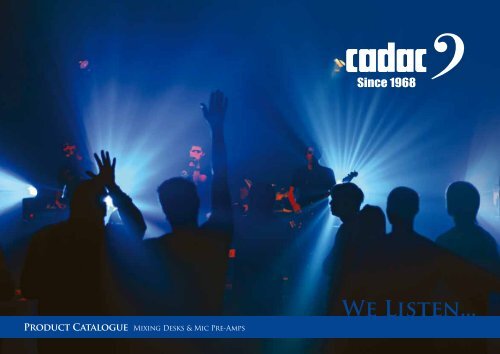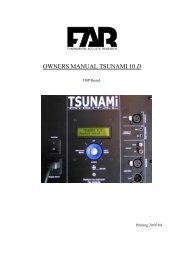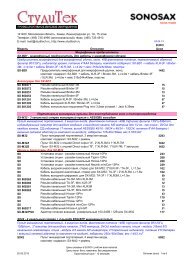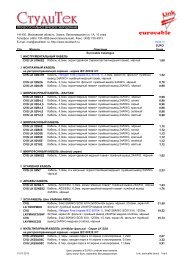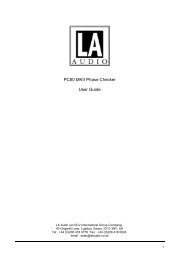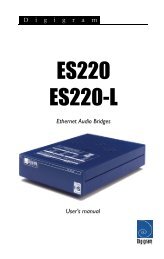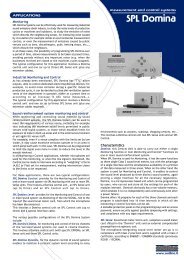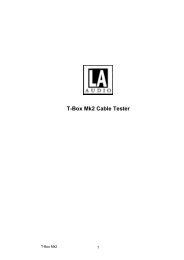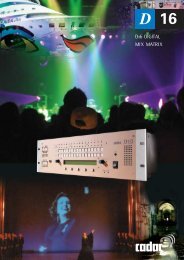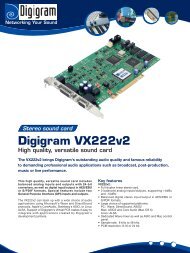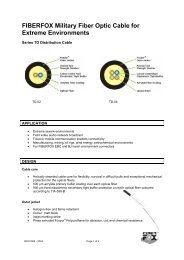You also want an ePaper? Increase the reach of your titles
YUMPU automatically turns print PDFs into web optimized ePapers that Google loves.
Since 1968<br />
Product Catalogue Mixing Desks & Mic Pre-Amps<br />
<strong>We</strong> <strong>Listen</strong>...
Contents<br />
Company Overview<br />
The Future is Here<br />
S-Digital 2<br />
Live Production Console<br />
J-Type 8<br />
Live Production Console<br />
F-Type 10<br />
Live Production Console<br />
R-Type 12<br />
Live Production Console<br />
S-Type 14<br />
Live Production Console<br />
C-Type 16<br />
Location Recording Console<br />
Specifications 18<br />
Analogue Console Performance Specification<br />
Live1 20<br />
Fixed Format Console<br />
DSSR 22<br />
Digital Series Stage Rack<br />
ME2 23<br />
2 channel microphone pre-amplifier and mixer<br />
Comparison Chart 25<br />
The Cadac name has been synonymous with top quality audio mixing<br />
consoles for over 40 years. From the earliest recording studio desks in<br />
the late 1960s, recording classic tracks from all major bands for over<br />
a decade, through to the latest live sound reinforcement consoles<br />
used in all prestigious theatres, the Cadac brand has always set the<br />
benchmark for quality. This is a unique and unparalleled pedigree in<br />
the world of professional audio equipment manufacturing.<br />
The Cadac name epitomises a blend of innovative electronic design<br />
and excellence of audio quality, supported by reliable performance<br />
and service simplicity in the great British tradition.<br />
Design, manufacture and test are all conducted at the company’s<br />
comprehensive facility in Luton, Bedfordshire, UK. This is fully<br />
equipped with the latest-generation electronic and mechanical design<br />
applications, complemented by state-of-the-art test and measurement<br />
facilities, including an EMC chamber.<br />
Cadac has earned itself an enviable reputation by delivering<br />
products that embody the company’s core tenets of providing sonic<br />
excellence, attention to end-user requirements and unparalleled<br />
return on investment. Cadac is therefore recognised as the industrystandard<br />
choice for leading musical productions, prestigious theatre<br />
installations, and the international touring circuit.<br />
2009 saw Cadac enter a new chapter following a US$6m+ investment from<br />
the Soundking Group Company of Ningbo, China. This major investment has<br />
fortified Cadac’s UK based operations significantly, resulting in strengthening<br />
the R&D team to progress new digital and analogue designs, and spearheading<br />
an expansion into new and exciting markets.<br />
Ultimately, the classic and sought-after ‘Cadac sound’ will be made available to<br />
a far wider audience.<br />
In addition to Cadac’s commitment to continue to manufacture and support our<br />
traditional legacy flagship consoles, 2009 witnesses the launch of a number of<br />
new products, with more scheduled to appear in 2010.<br />
Live series:<br />
Finally, the call for optimum audio performance in the first truly<br />
compact fixed-format Cadac console has been answered with the<br />
development of this range.<br />
Cadac Classic: A 19” rack-mount series of mic pres, EQs and effects, based on<br />
the audio circuitry from Cadac’s traditional, vintage and heritage<br />
products.<br />
Top left: Clive Green, company founder, pictured at Lansdowne Recording Studios in 1970.<br />
Left: The first Cadac recording desk, delivered to Morgan studios in 1968.<br />
Right: Cadac S-Digital in Tianmen Square during the National Day 60th anniversary celebration.<br />
1
Live Production Console<br />
Features<br />
Cadac’s S-Digital console brings together the benchmark audio quality, tools and features of theatre’s industry-standard console, the Cadac J-Type,<br />
but with a smaller footprint, and the operational and creative benefits of audio manipulation and control in the digital domain.<br />
Having conceived the S-Digital specifically to reflect the surface architecture of the J-Type, Cadac has fulfilled the desires and expectations of theatre<br />
sound designers and operators, by producing a console that sounds, looks and behaves like a familiar analogue desk. The S-Digital is designed from<br />
the ground up specifically for theatre sound applications.<br />
The console is designed for guaranteed performance, with all input and output modules hot swappable. The Cadac design philosophy, using embedded<br />
processing, ensures that any loss of the Control Surface Manager or Sound Automation computers does not affect console operation and, as with the<br />
J-Type, full redundancy backups on power supplies, inter-system communications, audio path and control are key features.<br />
Cadac’s new Paradigm for Live Sound<br />
> Digital technology with Cadac audio quality<br />
> Sounds, looks and behaves like a familiar<br />
analogue desk<br />
> Enables designers to set up a show quickly and<br />
effectively<br />
> Provides operators with immediate familiarity<br />
and comfort zone<br />
> Smaller footprint delivers tangible cost benefits<br />
to both show producers and theatre owners<br />
> 72-144 Input Channels, 66 Mix Busses, and 3<br />
Stereo <strong>Listen</strong> Busses<br />
> A Control Surface consists of four components<br />
– Input, Output and CCM Frames and a 19” 4U<br />
Control Surface Manager<br />
> A single Input frame has the capability to control<br />
144 input channels (Additional input control<br />
frames can be added)<br />
> A single Output frame has control over all 72<br />
outputs and listen busses<br />
2 3
System Architecture<br />
Control Surface<br />
The Control Surface consists of four frame components:<br />
input frame<br />
output frame<br />
Central Control Module (CCM) frame<br />
Control Surface Manager (CSM) rack<br />
Typical Connections<br />
Input Frame<br />
A single input frame has the capability to control 144 input channels in 8 layers or 8 user<br />
assignable banks.<br />
CSM<br />
The input frame comprises:<br />
> 18 input modules and fader modules (small parameter set)<br />
> 1 input Central Assign Module (CAM) and fader module (full parameter set)<br />
> 72 input LED bargraph meters<br />
> 1 CAM display module, with headphone source selection<br />
DSP<br />
Output Frame<br />
A single output frame has the capability to control 66 output and 6 listen busses in 4<br />
layers or 4 user-assignable banks.<br />
Central Control Module (CCM) Frame<br />
This controls the system set up and runs Cadac’s Sound Automation Manager (SAM2)<br />
show control system. It also houses a bespoke control section with dedicated one-touch<br />
function keys, a high resolution monitor, and housed in an independent 4U Control Surface<br />
Manager (CSM) rack interface dedicated communication and control interface processors.<br />
To further racks or control surface<br />
To further racks or control surface<br />
Power Supply<br />
Comms link1 (Coax pair)<br />
Comms link2 (backup)<br />
Frame Control<br />
Additional S-Digital frames can be specified to give dedicated hardware control over multiple inputs and bus outputs, mirroring the ability to link<br />
multiple J-Type frames together. The headphone output of each frame can be sourced from any of the three stereo listen busses, thereby allowing<br />
multiple operators simultaneously to configure and work on the desk.<br />
The acoustically silent power supply units, housed in a 2U 19” enclosure, contain two independently mains fed supplies. These can power<br />
individual system components or act as dual redundancy supplies. Status monitoring is provided locally to the PSU via the onboard<br />
OLED display, in addition to being fed back to the Central Control Module via the HSD comms system. The power connections to each<br />
rack or control surface are on 6-pin Cannon connectors, with PSU status data connecting locally to each rack via XLR-3 connectors.<br />
A Meterbridge<br />
B Channel Mute/PFL/Sel<br />
C Input CAM fader<br />
D Channel status OLED<br />
E CAM meter<br />
F CAM module<br />
G Mic pre controls<br />
H Bus sends<br />
I Input dynamics<br />
J Input EQ<br />
K Input fader<br />
L Output dynamics<br />
M Output EQ<br />
N Matrix sends<br />
O Output fader<br />
P DC master fader<br />
Q Output CAM fader<br />
R Output CAM module<br />
S Output CAM meter<br />
T Master mutes<br />
U P&N buttons<br />
V Custom keyboard<br />
W MIDI and Event indicators<br />
X PSU indicators<br />
4 5<br />
Y USB ports<br />
Z Trackball
System Racks DSP and I/O<br />
Specifications<br />
System Racks<br />
The DSP rack, plus each I/O rack and the control surface, communicate using Cadac’s bespoke HSD comms protocol via coax or fibre. Two independent<br />
paths exist for communications redundancy. The proprietary protocol transfers all audio and data throughout the system.<br />
DSP Rack<br />
A single 4U 19” DSP rack contains the SHARC devices that process the EQ and<br />
dynamics algorithms for each input and output channel, with capacity to cover<br />
the maximum amount of processing required for 144-channel 72 bus operation.<br />
A full system requires 9 DSP cards, leaving 3 additional physical slots within the<br />
rack allow for redundancy and future optional enhancements.<br />
The DSP algorithms have been carefully modelled to replicate the characteristics<br />
of Cadac’s traditional sound, whilst minimising audio latency and group delay<br />
artefacts.<br />
Two HSD comms cards are fitted within all racks to provide for main and redundant<br />
connections to other I/O racks and the control surface.<br />
I/O Rack<br />
Multiple I/O racks can be configured within a single system, with each rack<br />
capable of housing a user-configurable selection of analogue and digital audio,<br />
plus control interfaces. Each I/O rack is 10U high, which provides sufficient<br />
room for socket labelling and improved physical access, and is 12 slots wide.<br />
All analogue and digital circuitry adheres to our strict policy<br />
of providing optimum audio performance. As with Cadac<br />
analogue consoles, all analogue I/O is hand-tuned to achieve<br />
maximum common mode rejection and output balance<br />
performance.<br />
A simple socket assignment grid located in the CCM allows<br />
for assignments of the physical sockets in the IO racks to the<br />
desired input or output modules on the control surface.<br />
1 2 3 4 5 6 7 8 9<br />
1 8730 coax communications interface card<br />
2 8671 2 x 8 mic input on XLR3-F with signal<br />
present LEDs<br />
3 8672 16 x line input on TRS<br />
4 8820 16 x line output on TRS<br />
5 8788 16 x line input on XLR-3F<br />
6 8788 16 x line input on XLR-3F<br />
7 8821 16 x line output on XLR3-M<br />
8 8821 16 x line output on XLR3-M<br />
9 8757 optical fibre communications<br />
interface card<br />
Not illustrated<br />
8844 GPIO providing 8 x relay events - RS-232 MIDI In/Out - 2 x RS-485<br />
8804 coax and fibre based MADI I/O<br />
8936 AES/EBU - 4 x stereo pair In - 4 x stereo pair out<br />
8887 16 x line input on D-connector<br />
8888 16 x line output on D-connector<br />
88XX other proprietary digital audio format I/O card currently under development<br />
Analogue Inputs<br />
Input Impedance:<br />
Nominal Input Level:<br />
Max. Input Level:<br />
Reference:<br />
CMRR:<br />
Signal to Noise:<br />
Dynamic Range:<br />
THD:<br />
Frequency Response:<br />
Crosstalk:<br />
Digital Processing<br />
Internal Sampling Frequency:<br />
10k Ohm (electronically balanced)<br />
0dBu<br />
+ 24dBu (balanced) + 10dBu (unbalanced)<br />
+ 4dBu = -20dBfs<br />
-85dB (50Hz - 10kHz)<br />
-105dBu at zero gain<br />
119dB, 20Hz to 20kHz unweighted<br />
0.009%@ 1kHz, 10dB gain, + 4dBu<br />
5Hz to 65kHz: ± 0dB<br />
-80dB at 10kHz<br />
96kHz 24-bit<br />
Latency:<br />
analogue in analogue out < 800us<br />
Line Level Gain:<br />
± 10dB Input Trim<br />
-65 to + 10dB Channel Fader<br />
-75 to + 10dB Matrix Send<br />
-75 to + 10dB Output Fader<br />
Overall system frequency response at any analogue output: 5Hz to 45kHz (-3dB point)<br />
Overall system noise at any analogue output:<br />
-95dBu (input and output faders @ 0dB)<br />
Dynamic Parameters<br />
Gate Threshold:<br />
-70dBu to + 23dBu<br />
Attack:<br />
0.1ms to 250ms<br />
Release: 50ms to 2.5s<br />
Hold:<br />
25ms to 5s<br />
Compressor Threshold: -70dBu to + 23dBu<br />
Attack:<br />
100ms to 250ms<br />
Release: 50ms to 2.5s<br />
Hold:<br />
25ms to 5s<br />
Ratio: 1:1 to 25:1<br />
Knee Hard or Soft selectable<br />
Peak or RMS selectable<br />
Makeup Gain:<br />
0.0dB to + 30.0dB<br />
Delay:<br />
Adjustable DelayTime: 0.1ms to 400ms<br />
General<br />
Power Supply:<br />
19” 2U depth in mm 440 Requirements 90 - 250VAC 50/60Hz<br />
Dimensions: input frame/output frame in mm (WxDxH) 820.8 x 944.65 x 391.5<br />
CCM frame in mm (WxDxH) 455.04 x 944.65 x 391.5<br />
I/O rack 19” 10U x 504mm depth<br />
DSP rack 19” 4U x 504mm depth<br />
CSM rack 19” 4U x 504mm depth<br />
Analogue Outputs<br />
Impedance:<br />
Nominal Load Impedance:<br />
Nominal Output Level:<br />
Max. Output Level:<br />
Output Balance:<br />
Output Reference Level:<br />
Dynamic Range:<br />
THD:<br />
Frequency Response:<br />
Crosstalk:<br />
EQ Parameters<br />
4 band parametric (or 6 band 20Hz-20kHz)<br />
LF: 20Hz to 200Hz inc switchable shelf<br />
LMF: 60Hz to 600Hz<br />
HMF: 400Hz to 4.0kHz<br />
HF: 1.5kHz to 15.0kHz inc switchable shelf<br />
All bands ± 18dB gain Q 1.0 to 3.0<br />
HPF: 14.0Hz to 400Hz<br />
LPF: 1.0kHz to 35.0kHz<br />
EMC<br />
Complies with:<br />
< 100 Ohm (balanced)<br />
600 Ohm<br />
0 dBu<br />
+ 24dBu into 600 Ohm<br />
-65dB (50Hz - 10kHz)<br />
+ 4dBu = -20dBfs<br />
119dB, 20Hz to 20kHz unweighted<br />
0.008%@ 1kHz, 10dB gain, + 4dBu<br />
5Hz to 80kHz: ± 0dB<br />
-80dB@ 10kHz<br />
EN55103-1: Emissions<br />
EN55103-2: Immunity<br />
6 7
J-Type Live Production Console<br />
J-Type Features<br />
Launched in 1992 and continually evolving ever since, the Cadac J-Type Live Production Console has gained a reputation as the world’s leading<br />
console for major musical productions based on its combination of exceptional audio quality, reliability and functionality. The J-Type also has<br />
an exceptional track record for the rough life – touring extensively, and enduring long-running fixed installations in the world’s elite theatres,<br />
highlighting the versatility of its design.<br />
Cadac maintains a continual investment programme in the J-Type. Users can put any module in any position, configuring the console to suit the project<br />
in hand. For audio quality, the J-Type is the Cadac benchmark for exceptional performance. All of the inputs, insert send/returns and outputs are<br />
electronically balanced, as are all audio mixing busses. There is an impressive range of input and output modules to choose from: users can combine<br />
manual input and output modules with automated programmable dual input, stereo input and output channels to get the precise routing and mix<br />
required for every cue. This is complemented by the J-Type’s versatile matrix – with up to 16 sub and 32 matrix group outputs.<br />
The industry standard for musical theatre in<br />
London’s <strong>We</strong>st End, on Broadway, in the USA, on<br />
tour and in major theatrical districts from Germany<br />
to Seoul and Tokyo and all over the world.<br />
> Cadac’s unique “plug anywhere” modules for<br />
user configuration<br />
> Cadac’s fully programmable modules for<br />
performance control<br />
> Recall all DC master, routing, matrix send level,<br />
pot and switch settings, fader position* on a cueby-cue<br />
basis (SAM software)<br />
> Balanced Bussing<br />
> *Motorised fader option<br />
> 10 mono 1 stereo Aux, 16 group, 16 into 32 matrix<br />
and 15 DC Master Faders<br />
> Comprehensive PFL and Line Up system<br />
> Hand tuned common mode rejection and<br />
balancing<br />
> Custom Frame sizes up to 63 slots each can be<br />
bussed together in multiples to construct up<br />
to 32, 48 and more (up to 200) input channel<br />
configurations.<br />
> Dual power supply system<br />
Example Configuration<br />
32m+4s/12 group/24mtx<br />
64m+4s/16 group/32mtx<br />
96m+8s/16 group/32mtx<br />
Frame Combination<br />
52-slot<br />
52 + 36-slot<br />
48 + 40 + 40-slot*<br />
m: mono input module; s: stereo input module; mtx: matrix output<br />
8<br />
* console configured with fully programmable modules.<br />
9
F-Type Live Production Console<br />
F-Type Features<br />
Taking its design from the legendary J-Type, the same circuitry, mic preamp, EQ, and balanced bussing was designed into a desk primarily for<br />
performance venues and live rental companies, incorporating the fader into the module design to give a smaller front-to-back footprint, and<br />
without the extensive routing automation required of the J-Type.<br />
Controlled by the same SAM software, the F-Type offers basic automation over DC master assignments, channel on off and AB switching, mutes and<br />
motorised faders as an option. Many find homes in performance venues and arts theatres looking for this level of automation and audio quality, but<br />
on a more stringent budget.<br />
Ideally suited to repertory theatre, corporate<br />
events, venues, houses of worship, industrials and<br />
PA rental<br />
> Cadac’s unique “plug anywhere” modules for<br />
user configuration<br />
> Modular for easy serviceability<br />
> Recall all DC master, channel on/off, fader<br />
position* on a cue-by-cue basis (SAM software)<br />
> Balanced Bussing<br />
> *Motorised fader option<br />
> 16 Auxs, 12 groups, 12 into 24 Matrix and 12 DC<br />
Masters<br />
> Hand tuned common mode rejection and<br />
balancing<br />
> Dual power supply system<br />
> Custom Frame sizes up to 63 slots each can be<br />
bussed together in multiples to construct up<br />
to 32, 48 and more (up to 200) input channel<br />
configurations.<br />
Example Configuration<br />
32m+3s/12 group/24mtx<br />
64m+3s/12 group/24mtx<br />
Frame Combination<br />
52-slot<br />
48 + 36-slot<br />
m: mono input module; s: stereo input module; mtx: matrix output<br />
10 11
R-Type Live Production Console<br />
R-Type Features<br />
The R-Type Live Production Console is Cadac’s answer to touring sophistication contained within an easily re-configurable package. Taking the<br />
traditional circuits from the J-Type, and re-engineering them using surface mount components, the console combines touring ruggedness with the<br />
legendary Cadac audio quality, providing comprehensive facilities for both FOH and monitor mixing.<br />
A major benefit for rental companies is the ability to re-configure the console exactly to match each tour’s specification and budget, using Cadac’s<br />
unique “plug-anywhere” modules. A total of 53 mix busses and slimmer modules mean the R-Type is also a firm favourite for fixed theatre installations<br />
with its 32 into 16 matrix and where a smaller footprint is essential.<br />
Lightweight yet strong fixed monocoque frame<br />
design, for easy shipping and handling<br />
> Cadac’s unique “plug anywhere” modules for<br />
user configuration<br />
> Slimline modules - just 35mm (1.4 inches) - for a<br />
compact footprint<br />
> Multiple input frames allow for “per event”<br />
configuration<br />
> 32 Aux/Groups, 32 into 16 matrix and 16 DC<br />
Master Faders<br />
> Comprehensive 3 way listen/PFL system<br />
> Hand tuned common mode rejection and<br />
balancing<br />
> Fixed 24 slot Frame sizes can be bussed together<br />
in multiples to construct up to 32, 48 and more<br />
(up to 200 or more) input channel configurations.<br />
> Dual power supply system<br />
Example Configuration<br />
48m+3s/32 buss/16mtx<br />
72m+3s/32 buss/16mtx<br />
Frame Combination<br />
3 x 24-slot<br />
4 x 24-slot<br />
m: mono input module; s: stereo input module; mtx: matrix output<br />
12 13
S-Type Live Production Console<br />
S-Type Features<br />
Effectively a miniature R-Type, the S-Type compact modular mixer offers the same circuitry, mic<br />
preamp, EQ, and balanced bussing, just with fewer busses and different frame construction.<br />
Ideally suited to repertory theatre, corporate<br />
events, broadcast, performance venues, houses of<br />
worship, industrials and PA rental<br />
> Modular for easy serviceability<br />
> Balanced bussing<br />
> 6 mono 2 stereo Auxs, 8 groups, LR Stereo and 8<br />
DC Masters<br />
> Hand tuned common mode rejection and<br />
balancing<br />
> Three frame sizes - 17-slot, 25-slot and 33-slot<br />
can be bussed together in multiples to construct<br />
8, 16, 24, 32, 48 and more input channel<br />
configurations.<br />
It was designed to provide the ultimate solution for audio applications requiring a compact mixer<br />
without any compromises in terms of audio performance, serviceability or facilities. Many find homes<br />
in TV and radio broadcast, government department applications, and houses of worship, due to the<br />
exceptionally high audio quality and small size.<br />
Example Configuration Frame Combination<br />
10m+2s/4 group/LR 17-slot<br />
16m /8 group/LR 25-slot<br />
24m /8 group/LR 33-slot<br />
32m+4s/8 group/LR 25 + 17-slot<br />
44m+4s/8 group/LR 33 + 25-slot<br />
52m+4s/8 group/LR 33 + 33-slot<br />
60m+4s/8 group/LR 25 + 25 + 25-slot<br />
m: mono input module; s: stereo input module; LR: stereo master<br />
14 15
C -Type Location Recording Console<br />
C-Type Features<br />
Unique in the Cadac family, the C-Type uses a mic preamp, 3 band EQ design and fully-balanced bus<br />
system different from the rest of the Cadac family – the signal path is purely analogue, without the<br />
use of VCAs.<br />
The bus structure is designed for multitrack recording and mixdown, with special provisions made<br />
for extensive monitoring and metering in 2.0, 4.0 and 5.1 surround. Each input allows for mid-side<br />
recording techniques, with each channel incorporating right group only phase reversal.<br />
Ideally suited for high quality orchestral or film<br />
music recording<br />
> Modular for easy serviceability<br />
> Fully Balanced bussing<br />
> 4 mono 2 stereo Auxs, 8 groups, Stereo master<br />
> Calibrated and switched resistive network input<br />
gain with trim<br />
> 57dB scale input metering<br />
> Hand tuned common mode rejection and<br />
balancing<br />
> Dual power supply system<br />
> Custom Frame sizes up to 63 slots each can be<br />
bussed together in multiples to construct up<br />
to 32, 48 and more (up to 200) input channel<br />
configurations.<br />
Example Configuration Frame Combination<br />
16m/8 group/LR 24-slot<br />
24m/8 group/LR 32-slot<br />
32m/8 group/LR 40-slot<br />
64m/8 group/LR 40 + 32-slot<br />
m: mono input module; LR: stereo group master<br />
16 17
Analogue Console Performance Specification<br />
J-Type F-Type R-Type S-Type C-Type<br />
Analogue Console Performance Specification<br />
Microphone Input<br />
Electronically balanced; input impedance is 1k2 Ohms<br />
Gain is continuously variable from 10 to 60dB. CMRR is better than 80dB.<br />
Outputs<br />
All outputs are electronically balanced.<br />
The output impedance is 33 Ohms in series with 1000µF. The maximum output is +21dBu into 2k ohms.<br />
Mixing System<br />
All mixing busses are of the differential current summing type providing 80dB rejection of external noise fields. The system is so designed that the gain<br />
of the summing amplifier is proportional to the number of channels routed to the bus. For example, the basic noise contributed by a group-summing<br />
amplifier, with no inputs selected, is typically -105dBu.<br />
Complete Signal Path<br />
Output Noise:<br />
Frequency Response:<br />
Maximum Gain:<br />
Total Harmonic Distortion:<br />
Better than -85dBu<br />
+/-0.5dB 20Hz to 20kHz<br />
Microphone input to subgroup output = 80dB<br />
Output level into 2k ohms = +20dBu:<br />
20Hz 50Hz 100Hz 1kHz 10kHz 20kHz<br />
Live1 Fixed Format Console<br />
The Cadac Live1 Series is the first truly compact Cadac mixer, and the feature set<br />
reflects Cadac’s 40 years at the forefront of analogue mixing console design. The<br />
Live1 Series repackages many of the features of our world-famous large-scale<br />
theatre and touring desks in an extremely affordable package, whilst retaining<br />
the attention to detail, high quality audio circuitry and reliability on which the<br />
reputation of the Cadac brand is built.<br />
USP … “The addition of an innovative digital IO and networking interface as standard<br />
is a unique feature on a desk at this price point.”<br />
The Live1 is packed with the features you will need for FOH and monitor duties –<br />
with bands, performance venues, AV/rental companies or houses of worship.<br />
All input channels have<br />
> New Mic amp design with individual phantom power and high pass filter switching.<br />
> 4 band EQ with shelving high and low bands.<br />
> PFL and Mute. (AFL mode set from master section)<br />
> 100mm faders with signal present and overload indicators.<br />
> 6 Auxiliaries switchable pre/post in pairs and 600mm Aux master faders.<br />
> 4 Subgroups.<br />
> 4 stereo inputs on each desk as standard.<br />
> 6 returns (4 with sends to Aux 5/6).<br />
> 2 stereo returns on 100mm faders with sends to Subgroups and Aux 5/6.<br />
> LR Master Output section with dual outputs and talkback section.<br />
> The Live1 is available in 16/4/2, 24/4/2 (illustrated) and 32/4/2 formats.<br />
20
DSSR (Digital Series Stage Rack)<br />
ME2 2 channel mic pre-amp mixer with EQ<br />
Utilising the comprehensive facilities found in the Cadac M16 (Remote control mic pre-amplifier) and<br />
X16 (MADI merge unit), the Digital Series Stage Rack provides a unique and versatile solution to the<br />
problems and limitations so often encountered when dealing with professional audio production.<br />
No longer are numerous splitters, mic pre-amplifier units, audio converters and distribution systems<br />
required. The Cadac DSSR provides all this, within a scaleable system that can be flight-cased for<br />
portability. As an example, a system comprising four M16s, a single remote head (RM16) and an X16<br />
not only provides 64 remote controlled mic pre-amplifiers, but three analogue sends per pre-amplifier<br />
and eight MADI sends covering all 64 channels (irrespective of sample rate). If that wasn’t enough, you<br />
also benefit from the highly regarded and pristine quality of Cadac’s analogue and digital technology.<br />
Each M16 provides 16 microphone pre-amplifiers with adjustable gain from 10 dB to 60 dB, 20 dB Pad,<br />
48 V Phantom Power, Polarity Reverse, High Pass Filter (60 Hz @ 12 dB/Octave), Signal level indication<br />
and Channel Mute. Control over the microphone pre-amplifiers is provided either directly from the<br />
M16 front panel, or from the optional RM16 remote head.<br />
The X16 is the only unit currently available that can merge and distribute multiple optical MADI<br />
streams without a computer. Designed with both M16 integration and standalone operation in mind,<br />
the X16 can receive a total of four optical MADI input streams, either distribute or combine streams<br />
contiguously and redistribute them to 8 available outputs (four SC Optical connections and four Coaxial<br />
BNC connections).<br />
Providing two independent audio paths, each with dedicated Mic pre-amp and four band fully parametric EQ, the ME2 is ideal for capturing source<br />
material in its entirety and truest form. The mic-pre circuits and the EQ section are a copy of the acclaimed J-Type design. Each audio path is fitted<br />
with fully balanced Inserts, switchable pre or post EQ, in addition to balanced auto-compensating analogue outputs. An AES-3 output is also<br />
provided enabling direct connection to all digital audio workstations, digital mixing consoles or direct digital recording devices.<br />
Enhancing the ME2 feature set further, multiple ME2 units can be bus linked together to enable a small format multi-channel console to be created<br />
with each audio path having dedicated level/pan controls in addition to Mute and PFL control. *<br />
Features<br />
> 2 independent, discrete, electronically balanced and hand tuned Mic pre-amps (+60dB gain)> 4 band EQ with shelving high and low bands.<br />
> Additional Stereo mix bus on 15 way D-connectors for daisy chaining multiple ME-2 units together<br />
> Phantom power, polarity reverse, 20dB pad<br />
> 14-400Hz switchable variable high pass filter<br />
> Insert points on XLRs with pre EQ selection switch<br />
> 4 band switchable Classic Cadac parametric EQ<br />
> Mix bus level and pan control with PFL and Mute<br />
> 12 segment LED bar graph display switchable pre/post fade<br />
> Analogue hand tuned electronically balanced output<br />
> AES/EBU digital output switchable 44.1kHz, 48kHz, 96kHz, 16 bit, 24 bit Digital synchronisation via internal or external BNC word clock<br />
> USP… “innovative digital IO and networking interface”<br />
*in combination with the Cadac Classic MA2 Mix Amp<br />
22<br />
23
Cadac Holdings Limited<br />
One New Street, Luton, Bedfordshire, LU1 5DX, UK<br />
Telephone: +44 (0)1582 404202<br />
Facsimile: +44 (0)1582 412799<br />
Email: info@cadac–sound.com<br />
<strong>We</strong>bsite: www.cadac–sound.com<br />
© 2010 Cadac Holdings Limited. Cadac reserves the right to change specification without notice<br />
PC2010_Iss.1


